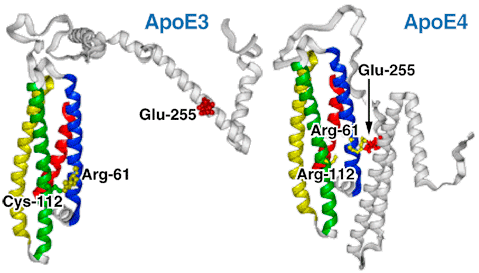摘要:一项新的研究可帮助解释为什么β淀粉样蛋白(这是阿尔茨海默症的一个标志)会在某些人的脑中(比其他人)积聚得更多。 这些发现可能会找到新方法来减缓甚至中止淀粉样板块在患者脑中的积聚。 研究人员确定了数个看似会令罹患阿尔茨海默症风险增加的基因,但风险基因APOE及其蛋白APOE-e4仍然是发生该疾病的最强的风险因子。 APOE-e4是APOE基因的三种常见蛋白形式中的一种(另外2种是APOE-e2和APOE-e3)。
以往的研究提示,APOE-e4会以某种方式帮助促使β淀粉样蛋白的积聚,这些蛋白会在阿尔茨海默症病人的脑中簇集在一起以形成淀粉样斑块。David Holtzman及其同事在这里证明,APOE-e4是通过减缓β淀粉样蛋白从脑中被清除的速度而促进其在脑中的积聚的。
首先,文章的作者对年龄在70岁以下的带有不同形式APOE的认知功能正常者的脑液进行了观察。该研究小组发现,那些带有APOE-e4的个人会比那些带有APOE-e2和 APOE-e3的人在脑中积聚更多的β淀粉样蛋白。
研究人员应用一种叫做微透析的技术来观察基因改造小鼠(这些小鼠会表达所有形式的人类APOE蛋白)中的β淀粉样蛋白的浓度。他们在表达人类APOE-e4的小鼠中发现了比那些表达E3或E2形式蛋白的小鼠中所发现的更高的β淀粉样蛋白浓度。重要的是,该研究团队还显示,带有人类APOE-e4的小鼠(包括年幼和年长的小鼠)其清除脑中β淀粉样蛋白的速度要比那些表达其它形式的该蛋白的小鼠的清除速度慢很多。这些结果显示,APOE-e4可造成β淀粉样蛋白的积聚并有更大的罹患阿尔茨海默症的风险。

APOE-e3和APOE-e4
生物探索推荐英文论文摘要:
Human apoE Isoforms Differentially Regulate Brain Amyloid-β Peptide Clearance
ABSTRACT
The apolipoprotein E (APOE) ε4 allele is the strongest genetic risk factor for late-onset, sporadic Alzheimer’s disease (AD). The APOE ε4 allele markedly increases AD risk and decreases age of onset, likely through its strong effect on the accumulation of amyloid-β (Aβ) peptide. In contrast, the APOE ε2 allele appears to decrease AD risk. Most rare, early-onset forms of familial AD are caused by autosomal dominant mutations that often lead to overproduction of Aβ42 peptide. However, the mechanism by which APOE alleles differentially modulate Aβ accumulation in sporadic, late-onset AD is less clear. In a cohort of cognitively normal individuals, we report that reliable molecular and neuroimaging biomarkers of cerebral Aβ deposition vary in an apoE isoform–dependent manner. We hypothesized that human apoE isoforms differentially affect Aβ clearance or synthesis in vivo, resulting in an apoE isoform–dependent pattern of Aβ accumulation later in life. Performing in vivo microdialysis in a mouse model of Aβ-amyloidosis expressing human apoE isoforms (PDAPP/TRE), we find that the concentration and clearance of soluble Aβ in the brain interstitial fluid depends on the isoform of apoE expressed. This pattern parallels the extent of Aβ deposition observed in aged PDAPP/TRE mice. ApoE isoform–dependent differences in soluble Aβ metabolism are observed not only in aged but also in young PDAPP/TRE mice well before the onset of Aβ deposition in amyloid plaques in the brain. Additionally, amyloidogenic processing of amyloid precursor protein and Aβ synthesis, as assessed by in vivo stable isotopic labeling kinetics, do not vary according to apoE isoform in young PDAPP/TRE mice. Our results suggest that APOE alleles contribute to AD risk by differentially regulating clearance of Aβ from the brain, suggesting that Aβ clearance pathways may be useful therapeutic targets for AD prevention.







